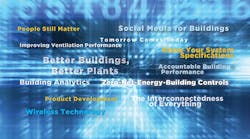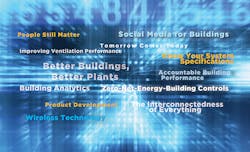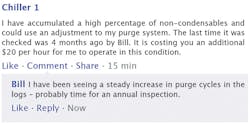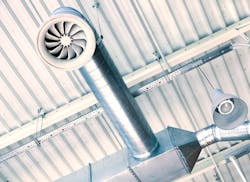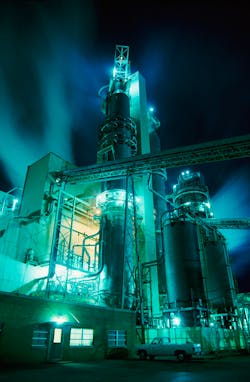To read Part 1, CLICK HERE.
Social Media for Buildings
By LEROY WALDEN, president, InsideIQ Building Automation Alliance, and vice president, McKenney’s Inc.
Smart buildings, the Internet of Things, big data—all current and relevant terms part of the new connected-building paradigm. Thermostats that “learn” our preferences and habits, lighting controls that recognize our presence and adjust to our needs—these now are widely available for the home and the workplace. Facility managers have access to building-automation data outside the control room on phones and tablets. With the almost universal acceptance of mobile devices and connectivity, as well as the proliferation of social media, the future of building management is a personal interaction between facility managers and operators and building systems, what can be called “social media for buildings.”
What if building managers could “friend” and have private conversations with their chillers to better understand how the chillers are doing and what they need? Better yet, what if chillers posted to managers’ timelines updates with helpful comments that reduced diagnostic time and pointed facility teams to immediate, impactful adjustments that curbed the chillers’ energy appetite?
Social media for buildings is organized around the items most interesting and valuable to individual facility operators, based on their profiles and what information has interested them previously. Now, operators do not have to go through pages of data to find the information most important to them because a rich network of information on the facility has been curated specifically for them. Building operators receive needed information from equipment, systems, and people. Plant logs are presented as continuously updating infographics that can be reviewed, commented on, shared, and/or published easily.
With social media for buildings, facility-team members receive information on the topics of greatest interest to them and can share that information with others in the facility, sparking social interaction around the data. Value is created as groups engage in conversations about the functionality and operations of the building, and communities form around products, systems, and applications. Eventually, new services built around social connectivity and compatible products come forth.
People Still Matter
By JAY ALTHOF, president, Unison Comfort Technologies
During the mid-1980s, our industry began developing computerized selection and design tools to improve accuracy and response times. By the end of the next decade, much of the information these tools produced was being shared on the Internet, and many started to wonder if computers would reduce or eliminate the need for human interaction and marginalize the knowledge of experienced designers.
Two decades later, the amount of technical information available at the click of a mouse is nothing short of amazing. Further, social-media tools such as Facebook and LinkedIn provide ways for professionals across the globe to connect. Yet the goal of designers remains the same: create systems that meet the needs of building owners by balancing system performance, first cost, and operating cost. Given ever-evolving HVAC technology options, knowing what products are available and how they will perform remains a challenge. While search engines and the Internet provide access to many gigabytes of product data, the system designer still must use logic and good judgement to sort through all of that data and make informed decisions. People still matter!
Interestingly, on our company website, one of the most-viewed pages provides the background of our management team. All of us look to develop relationships with people we can trust and who have proven they are able to give us solid advice. Given the vast amount of data available, that trusted advisor is even more important. The knowledge, experience, and wisdom of people collaborating can convert data into useful information and, ultimately, positive action.
So, while we will continue to develop increasingly powerful and mobile software tools, the positive relationships we develop—and enhance through social media—will remain a vital element of business. It is not a trade-off between technology and relationships. Rather, relationships enhance the impact technology has on our industry.
Tomorrow Comes Today
By ALEX HERCEG, analyst, Lux Research Inc.
Though HVAC has been widely deployed in commercial buildings since the 1920s, improvements in equipment performance largely have come incrementally. Today, however, we are witnessing unprecedented development focused on advanced HVAC and building energy management.
Historically, commercial-building HVAC has been a notoriously difficult market for new entrants, as large companies on both the equipment side and the building-sensing-and-controls side have dominated the landscape. These incumbents use an outdated “turf war” approach that is ripe for disruption by startups. In particular, nimble companies with segment-specific offerings are shaking up building energy management. From novel data-aggregation platforms to analysis, the connectivity of Internet of Things devices is giving facility managers new data-rich tools. Equipment manufacturers and facility managers who are embracing these new tools are moving ahead of the pack.
Green-building rating schemes, such as LEED, increasingly emphasize energy performance, but also award credits for thermal comfort and enhanced HVAC controllability—human-centric factors. This is especially important for commercial buildings, which accounted for 57 percent of certified floor space (across 18 rating systems) globally in 2014.
Technologies enabling enhanced ventilation will see strong growth in the near term. Specifically, startups working with energy and enthalpy recovery, as well as indoor-air-quality (IAQ) sensing, will benefit. Ventilation and IAQ are receiving a regulatory push, but also market pull in the form of third-party certifications, which globally are growing at a compound annual growth rate of 13 percent.
Many equipment providers are “servitizing” hardware-heavy HVAC offerings. The model of widespread, invasive energy-performance contracting is outdated. Many new entrants bundle expensive hardware into a service, in some cases financed by third-party lenders. Companies are driving growth rates as high as 300 percent year-on-year using this approach, a trend we expect to proliferate.
In 2016, building owners and operators have a plethora of options for gathering data and managing HVAC. The time for action is now.
Improving Ventilation Performance
By DAVID W. BEARG, PE, indoor-environmental-quality specialist, Life Energy Associates
While there is a lot of talk about the importance of providing a healthy indoor environment, all too often, opportunities to improve ventilation performance are missed, as design engineers are stuck doing things the way they always have. In 2016, there may be an awakening to this sad reality, as the next mutation of a respiratory virus invades a mechanically ventilated building, causing widespread illness. Unfortunately, we are ill-prepared to protect people against the spread of these viruses in the way we design and operate mechanically ventilated buildings.
Two oft-repeated failures to improve ventilation performance are:
- The use of local thermostats to control variable-air-volume (VAV) boxes in variable-occupancy locations. What happens here is a space, being overcooled prior to occupancy, experiences a delay until the thermostat notices a rise in temperature sufficient to signal the VAV box to deliver more than the minimum supply of air. The result is significant underventilation for the early part of a gathering—ample opportunity for the sharing and spread of a virus.
- The basing of air-movement geometry on the mixed-air concept, as opposed to the displacement approach, which provides greater separation, with improved capture and removal of human-generated bioeffluents, including viruses.
Both of these design deficiencies can be corrected with the use of an occupancy sensor to turn on an exhaust fan promoting air movement through a space, with air coming in low and leaving at ceiling level.
In addition to making the geometry of air movement through occupied spaces a priority, improved measurement of actual ventilation performance can lead to improved management of said performance. Remember: You can’t manage what you don’t measure.
Product Development
By KAREN MEYERS, vice president of government affairs, Rheem Manufacturing Co.
The future of HVACR rests in Washington, D.C. Let me start by quoting French philosopher and author Voltaire: “Perfection is attained by slow degrees; it requires the hand of time.” That should be the motto of the HVACR industry right now, but, instead, what’s really going on behind the scenes on Capitol Hill are tons of meetings that will make manufacturers redefine products too quickly.
A decade of change. With firmer rules on the horizon, a new generation of commercial appliances will hit the market in the next decade. The regulatory landscape—from tougher efficiency standards to more environmentally friendly refrigerants—is shaping all markets and driving our whole business. In fact, right now, the Department of Energy is pushing energy efficiency to cut back on power-plant greenhouse-gas emissions, and the Environmental Protection Agency wants lower global-warming potential when it comes to refrigerants. In this day and age, almost all of our product development is being motivated by regulatory standards.
Challenges. From a lobbyist like myself to engineers and product developers, we have to stay on top of all of the potential amendments happening on the government level because we can’t design products overnight. Testing and launching products takes a lot of time because of not only ever-changing federal regulations, but state and regional rules. Appliances must be able to transform to fit the needs of thousands of different combinations of applications; one size cannot fit all.
The age-old saying is change is good. I agree—to a point. Change is good when it comes to improving products, but it needs to slow down for engineers and product developers to catch their breath. We have numerous government agencies wanting change at the same time. I think the folks on Capitol Hill can take a little advice from Winston Churchill, who said, “There is nothing wrong with change, if it is in the right direction.”
Better Buildings, Better Plants
By TOM EWING, freelance writer specializing in energy and environmental issues
There’s little doubt energy will remain a top priority for plant managers in 2016. Whether concerning costs or the environment, energy will continue to challenge.
Here’s a smart move for 2016: Take a look at the U.S. Department of Energy’s (DOE’s) Better Buildings, Better Plants Program and Challenge (Better Plants).
Through the Better Plants Program, manufacturers set and commit to meeting specific goals regarding energy saving. Through the Better Plants Challenge, they additionally agree to share energy-performance data and energy-efficiency solutions. The DOE, in turn, provides recognition and support, including access to energy-analysis software tools, training, and networking opportunities.
To date, nearly 160 companies representing approximately 2,400 facilities are participating in Better Plants. With a combined energy footprint greater than the state of Tennessee’s, they have saved about 457 trillion Btu and $2.4 billion in energy costs. The average annual improvement rate is about 2.1 percent.
Better Plants is voluntary and non-regulatory. Signup is easy—you won’t have to stay late at the office to complete the two-page application—and you can withdraw or become inactive at any time.
Importantly, this is a dynamic program. For 2016, the DOE is planning additional in-plant training opportunities with a focus on process cooling/refrigeration. Other initiatives will deal with a new packaged combined-heat-and-power accelerator, an improved guide for energy management, and an expanded Better Buildings Solution Center, which contains nearly 200 tested and proven energy-efficiency solutions. And in May, the 2016 Better Buildings Summit will be held in Washington, D.C. (To view HPAC Engineering’s Calendar of HVACR Training and Education Events, click here).
Better Plants’ Fall 2015 Progress Update lists accomplishments by 3M, Bentley Mills, Ingersoll Rand, Volvo, and others. Very likely, you know someone, either casually or professionally, at one of Better Plants’ partner companies. It might be worthwhile to reach out for a first-hand report.
In 2016, with climate change looming over the world’s environmental agenda, intense energy users will draw new and added scrutiny, and officials fresh off the 2015 Paris Climate Conference will be looking to take action. Better Plants can help you stay out front on difficult and costly issues.
Know Your System Specifications
By DAVID YANCOSKY, central-plant optimization and maintenance expert, P2S Engineering Inc.
I began my professional life as a watchstander on a nuclear submarine for the U.S. Navy. Essentially, my job was to tour the engine room and monitor the temperatures and pressures of equipment, with the objective to maintain conditions within certain parameters, or in specification. With conditions in specification, we were assured the submarine propulsion plant would turn the propeller. Conditions that were in specification were said to be in the “green band.”
As a consultant, I essentially still stand watch, and I still am concerned with making sure conditions are in specification. As in the engine room of that nuclear submarine, when engineering conditions in a facility are in specification, we know we are moving forward. Instead of turbine steam pressures and reactor power conditions, I now watch chiller percent load and electrical energy use. I still use the term “green band” as an indicator of effectiveness, but that term, almost as if by fate, has taken on a different context.
Situational Awareness
When I am called to a central plant or facility, I start a dialog with the local stakeholders by asking, “What is the status of your system specifications?” I am not expecting those folks to recite chiller efficiency, cooling-tower approach, or the kilowatts per gallon per minute of the chilled-water system; if they were aware of the status of those specifications, I probably would not have been consulted in the first place.
The purpose of my inquiry is to call attention to what I believe to be essential to maximizing the total business efficiency of central plants and facilities: specification awareness. Actual engineering conditions are important, but to best serve the cause of total business efficiency at a facility, I promote specification awareness, which enables on-site crews to self-manage their systems. Although crews that self-manage their systems still need to outsource system tuning and other specialized services, they are more sophisticated in their relationships with vendors.
Let’s Take Some Logs
My next question pertains to data that already may exist. Specifically, I am looking for commissioning reports. A commissioning report details conditions recorded at a specific point in time, such as following new construction, a retrofit, or a tune-up. Some of these conditions are chiller energy use vs. chiller production, condensing-water-pump gallons per minute vs. energy use in kilowatts, and chilled-water gallons per minute vs. energy use. Naturally, I first focus on conditions that consume large amounts of energy.
Armed with data from a commissioning report, I create a log sheet. A log sheet simply is a piece of paper on which I record key specifications. I directly transfer “as commissioned” information to the log sheet, ensuring the data are catalogued “as commissioned.” Next, I record current values of key conditions. When there are large variances between current conditions and initial recordings, further investigation is needed.
Importantly, values are recorded for the log sheet on a regular basis. For example, chilled-water-pump gallons per minute vs. kilowatts is recorded daily or at least weekly.
A typical discovery is that chilled-water pumps are using more energy to move a certain amount of water. This may be the result of a failure to re-inspect and clean pump suction screens fouled with “new construction” debris. When energy variances are equated to dollar variances, on-site crews see the value in monitoring (and correcting) conditions before they become an issue of financial waste. Real impact is realized when a measurable improvement in a condition is affected, and the ancillary dollar savings are recorded and understood by the crew.
The key to this exercise is to focus local attention on specifications and the fact conditions can—and will—degrade. Condition degradations lead to increased costs, but local crews can maintain the upper hand through monitoring. Energy-management-system- (EMS-) enabled trending is a great tool; however, because of EMS archiving limitations, trends are captured over a relatively short period of time, such as a week, when it may take a year or longer for a large-consumer energy condition to show actionable trends. More importantly, there is benefit in engaging a crew in watchstanding activities, such as taking logs: By viewing and writing down engineering conditions, the crew takes ownership of specifications.
When facility operators are cognizant of equipment specifications, they are enabled to proactively manage the relationship between the HVAC product and the resources required to provide it.
Accountable Building Performance
By THOMAS HARTMAN, PE, HVAC engineering and technology developer, The Hartman Co.
Overwhelmingly, the scientific community has concluded severe environmental consequences will result if current growth in fossil-fuel use is not dramatically reversed. For more than a decade, the commercial-building industry has been aware of the important role it can play in such change through improved efficiency. However, over that time, the overall energy-use index of newer buildings has seen almost no change, although we know the overall energy use of commercial buildings is more than double what it could be if the buildings were operated optimally.
Energy performance projected during design is by itself entirely ineffective as a means to achieve long-term building energy efficiency. As a result, actual energy performance is becoming the metric to determine whether buildings meet energy-performance requirements. Engineers are nervous about this change in focus, as they have little influence on decisions made during building construction and operation. This is a reasonable concern, but I believe its resolution will lead to a transformation of our industry. True, designers should not be entirely accountable for actual building performance, but designers must take responsibility for developing construction documents that ensure the systems they design operate effectively and efficiently once buildings are operational.
How can they do this? My answer is to include in construction documents an entity accountable for performance through a regimen of analysis, oversight, and monitoring-based performance verification for at least several years following building startup. While such an entity cannot be responsible for overall building energy use, it can ensure that all of a building’s energy systems operate at designed efficiencies and work with the operations staff to make certain the systems are leveraged properly to achieve overall building-performance objectives. Such optimization firms are taking hold in the industry, but to date are limited to marketing their services to owners after buildings have been constructed. Designers need to become much more familiar with these firms and include them in the construction process to ensure decisions affecting the operating efficiency of a building are made correctly and that the operations staff has a knowledge resource as required to operate the building effectively and efficiently to meet the energy budget from the start.
Ultimately, building owners must be the ones accountable for overall building performance. But designers need to take responsibility to ensure owners and operators have the ongoing monitoring and technical support needed to be accountable. I am certain implementation of such procedures will be a win for everyone. We already are seeing such support can reduce overall building operating costs. This year should be the one in which we reach consensus and begin mainstreaming a truly effective accountability process that achieves the levels of building performance we know are possible. To this end, I invite all in our industry to join in and contribute.
I welcome your thoughts and ideas. Please contact me at [email protected].
Zero-Net-Energy-Building Controls
By RAWLSON O’NEIL KING, communications director, Continental Automated Buildings Association
Market research firm Freedonia forecasts demand for HVAC equipment to increase 6.8 percent annually through 2019—about twice the rate from 2009-2014—reaching $20.4 billion. In large part, advances will be the result of robust gains in building-construction spending, especially in improvement and repair expenditures. Advances also will be propelled by increasing demand for more efficient systems. The non-residential market will continue to comprise the larger share of overall HVAC-equipment demand in terms of value because of the larger size and subsequently higher cost of the systems used in these buildings. However, growth in the nonresidential market will be significantly outpaced by that in the residential market, as the number of new housing units will grow substantially through 2019.
In terms of innovation in HVAC, the Continental Automated Buildings Association (CABA) expects a key driver to be the emergence of buildings that no longer are completely dependent on the electrical grid. A recent study commissioned by CABA and conducted by the New Buildings Institute titled “Zero Net Energy Building Controls: Characteristics, Energy Impacts and Lessons” examines how existing and emerging monitoring and control technologies are helping building owners, operators, and occupants achieve and maintain zero-net-energy (ZNE) performance. ZNE buildings are emerging in response to energy-efficiency and carbon-reduction policies, as well as market interest in “green and sustainable” environments.
The report indicates building and system-level controls can be a cornerstone of improved performance or a weak link creating challenges for design teams and operators. CABA is distributing the report to industry stakeholders free of charge. To download the report, click here.
Building Analytics
By CHRIS LOFASO, PE, president and CEO, Envise, building-management-systems integrator
It should go without saying that building operators want improved efficiency, dependable comfort, and reduced energy costs. Since the early 1980s, building automation systems (BAS) have been playing an integral role in our ability to achieve these outcomes for our customers. Thousands of these complex systems have been installed globally; however, despite significant capital investments, their full potential oftentimes is not realized. The result is less than optimal building performance. Enter building analytics, which can help maximize the return on a BAS investment.
Building analytics essentially sits on top of a BAS and extracts data from the building to provide new dimensions of data evaluation for the customer; it’s like having a second set of eyes—one that not only sees issues, but provides guidance—on a building. For example, with fault detection and benchmarking, building analytics provides a big-picture view and can help to reduce energy costs, establish a baseline of performance, provide continuous commissioning, and help focus on the right areas for retrofit in the future. A key factor of building analytics involves the use of an open-protocol system, which is a non-proprietary system allowing total access to building data from a BAS or factory-mounted controllers.
As technology continues to evolve, we see a number of trends taking place in our industry. The first is the Internet of Things, which is driving the ability to acquire a greater volume of data more cost-effectively. The second is that more and more data and data operations are taking place in the cloud, as opposed to local BAS. The adoption of building analytics essentially leverages these two trends. Looking at all of these trends collectively and peering into the long-term future, I expect we will see more and more BAS, and controls functionality will follow the path analytics has taken and migrate to the cloud.
Overall, the combination of BAS and building analytics provides a sophisticated, powerful tool for facilities. The sum total of these two systems working together is greater than the sum of their parts and helps customers to leverage their BAS investments. It is becoming increasingly important for HVACR specifiers and engineers to understand and invest in analytics to help optimize customers’ building performance.
The Interconnectedness of Everything
By BRENDAN OWENS, chief engineering officer, U.S. Green Building Council
Is anybody else confused about how to spot the trend that will dominate conversation and action in the buildings industry in 2016? Health and wellness? Resilience? Carbon emissions? Smart buildings? Smart cities? Water?
It seems, from where I sit, that maybe the idea of one “it” thing for 2016 misses the interconnectedness of everything. Maybe what we all should be focusing on is being much more proactive about how our piece of the puzzle fits into the rest of the pictures that yield our total built environment. At the U.S. Green Building Council (USGBC), we call this integrative process. Integrative process isn’t a new idea. In fact, it’s a very old one. The “master builder” is a concept that predates the establishment of architecture and engineering as professions. As our industries have hyper-specialized and segmented, many of us have lost sight of the idea of the whole.
Returning to the idea of an “it” issue for 2016, you likely will get hit with several, and though they might seem mutually exclusive, they’re not. What’s the point of a resilient building that exacerbates climate change (one of the things to which a building needs to be resilient)? Water and health are inextricably linked. Can you have a smart building that doesn’t deliver carbon reduction and health outcomes? When you’re faced with this onslaught, take a step back and think like a master builder. Help your clients/customers take a systems approach to the design or operations challenge you’re facing. If you’re an owner, don’t settle for partial solutions that solve one problem, but cause five others.
USGBC and partner organization Green Business Certification Inc. (GBCI) are in the midst of a significant expansion of tools to assist in the design, construction, operation, and maintenance of the built environment. This toolbox—including LEED, or Leadership in Energy & Environmental Design, for buildings and neighborhoods, the WELL Building Standard for health and wellness in buildings, Performance Excellence in Energy Renewal (PEER) for transformation of the power industry, and the Sustainable Sites Initiative (SITES) for landscapes—provides specific tools for specific jobs for different stakeholders responsible for the development and operation of our built environment. The interrelatedness of these tools, however, is front and center in all of the work the USGBC and GBCI are doing. We want WELL-certified spaces in LEED buildings. We want LEED-certified buildings to be good neighbors on the grid so PEER-certified power systems can rely on them for power quality, demand response, and resilience. We’ve built, and will continue to evolve, these tools to deliver 1 + 1 = 3 (or 5 or 7) outcomes.
As a society and, more specifically, as an industry, we’re faced with some pretty daunting challenges ahead. So, to quote a big hero of mine, who made this point at our recent Greenbuild International Conference & Expo: “There’s work to be done. So we do it.” But I’ll close with adding one word to the end of that thought: “together.”
Wireless Technology
By DAVID MOLIN, vice president of controls, Trane
Emerging wireless technology is enabling shifts in traditional business practices and helping building owners address the demand for flexible building space while meeting building efficiency goals.
Many building owners want equipment options that allow building spaces to be flexible and meet the needs of office staff. Recent advances in wireless technology address this evolving trend by utilizing open platforms that support open standards, such as BACnet. This allows easy integration of devices as building needs change or expand.
Advances in wireless communication also have brought the operational capabilities that modern building systems provide to older and historic structures. Wireless technology integrated with building controls allows for unified control of multiple systems and remote management. Equipment that runs efficiently remains a high priority for building owners, and today’s wireless technology provides options that match or exceed the level of performance found with wired systems.
With all of the advances in wireless technology that have been made, engineers and building owners need to be aware of all of the options available to find the right wireless technology for their application.









